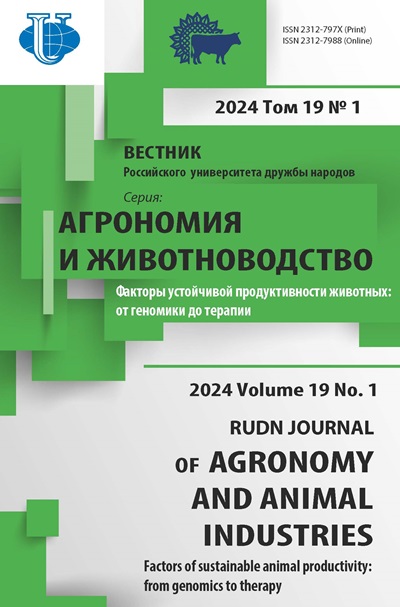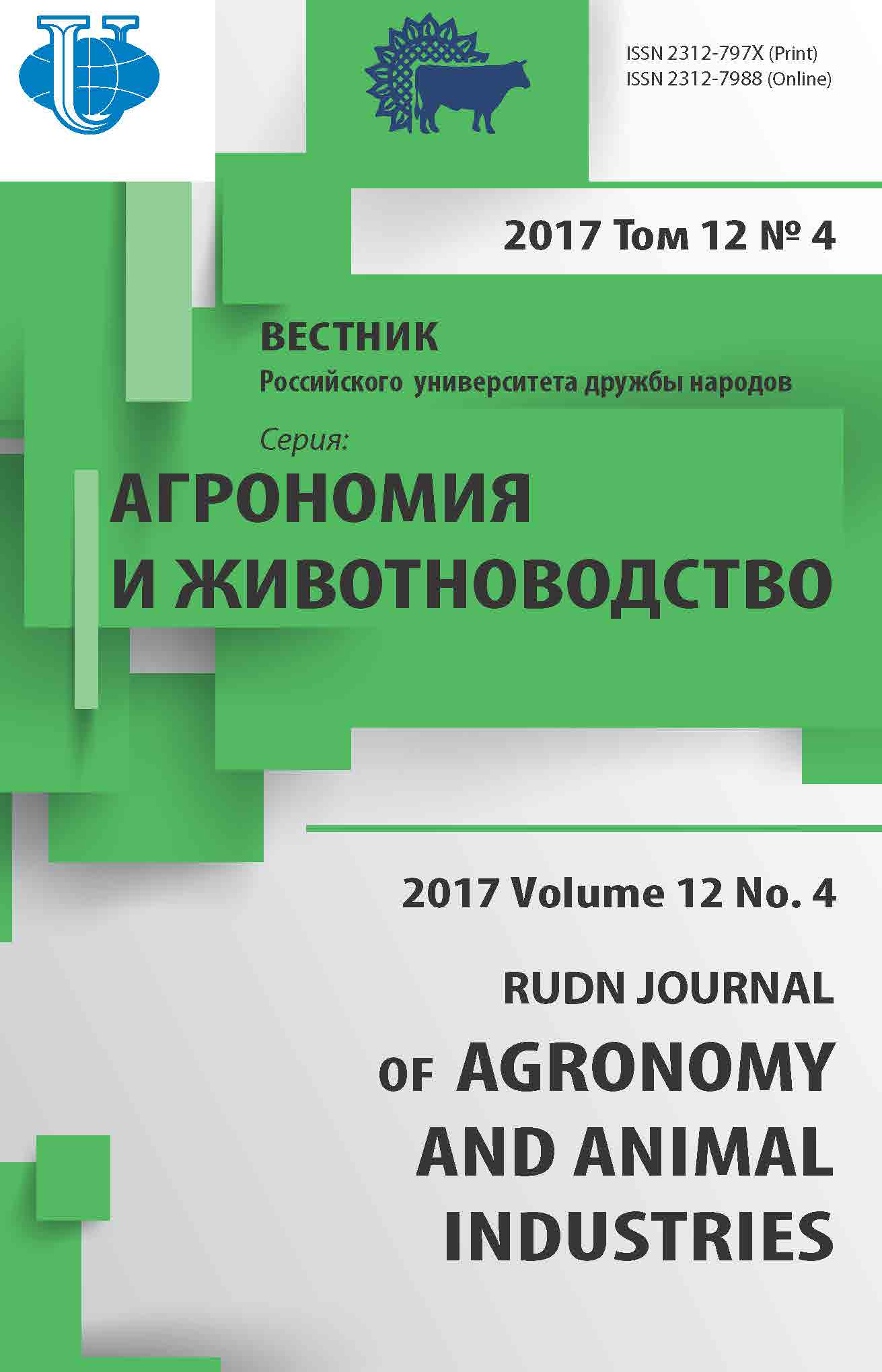MORPHOLOGICAL RESPONSE OF BITTER ALMONDS (PRUNUS AMYGDALUS) TO NITROGEN NANO-FERTILIZER IN EARLY STAGES OF GROWTH
- Authors: Badran A1, Savin IY2
-
Affiliations:
- 1 Peoples’ Friendship University of Russia (RUDN University)
- V.V. Dokuchaev Soil Science Institute
- Issue: Vol 12, No 4 (2017)
- Pages: 312-322
- Section: Articles
- URL: https://agrojournal.rudn.ru/agronomy/article/view/17474
- DOI: https://doi.org/10.22363/2312-797X-2017-12-4-312-322
Cite item
Full Text
Abstract
The use of large quantities of chemical fertilizers caused in many harmful to humans, animals and the environment. Adding to that, the difficulty of using nitrogen fertilizers especially urea and loss a large amount of it in sandy soil (70%) by leaching. In the other side, using of nano-particles and nano-powders, can produce controlled or delayed releasing fertilizers. This strategy could be reduced leaching of fertilizers as the release occurs gradually and continuously. Hence, this experiment was conducted to study the effect of nano-fertilizer on morphological response of bitter almond rootstock at germination period and the first stages of growth compared to other chemicals fertilizers. The nuts were soaked in dis-tilled water for 48 hours. Subsequently, the seeds were sown in perlite and treated with different concen-trations of nano-fertilizer, urea and ammonium sulfate at 0%, 25%, 50% and 100% for each, then stratified at 6 C for 8 weeks. After cold stratification, non-germinated seeds were exposed to 22 C for three weeks to promote germination. Germinated seeds were sown in pots with a mixture of peat and perlite. The treatments were arranged in a randomized complete block design in factorial experiment with 3 repli-cates and 25 seeds for each replicate. The results revealed that, nano-fertilizer affected significantly on seed germination and first stages of bitter almond growth. Whereas, pre-treating seeds of bitter almond rootstock with 50% of nano-fertilizer positively increased germination measurements; germination per-centage, germination rate and index due to enhancing the amount of water that penetrates inside the seeds during the germination period which in turn improved the biological activity of stored food thus in-duced embryo to germinated early. Added to that, nano-fertilizer markedly increased stem length and diameter with producing stronger seedlings which had the tallest and deepest underground parts as well as length of primary and secondary roots/plant and number of secondary roots/plant. It can be attributed to that; nano-fertilizers are available for absorption and can provide all nutrients that required for plant growth throughout its slow release of fertilizer therefore reduce nitrogen fertilizer lost by leaching and elevate nitrogen utilization efficiency by plant comparing to other nitrogen fertilizers that are lost about 70% of its nitrogen content by leaching.
About the authors
A Badran
1 Peoples’ Friendship University of Russia (RUDN University)
Email: dr_antar_mahmoud@yahoo.com
Miklukho-Maklaya st., 6, Moscow, Russia, 117198
I Y Savin
V.V. Dokuchaev Soil Science Institute
Email: savin_iyu@esoil.ru
Pyzhyovskiy str., lane 7, building 2, Moscow, Russia, 119017
References
- Ni B.L., Liu M.Z., Lue S.Y. Multifunctional slow release urea fertilizer from ethyl cellulose and super absorbent coated formulations // Chemical Engineering Journal. 2009. Vol. 155. P. 892-898.
- Zheng T., Liang Y.H., Ye S.H., He Z.Y. Superabsorbent hydrogels as carriers for the controlledrelease of urea: experiments and a mathematical model describing the release rate // Biosystems Engineering. 2009. Vol. 102. P. 44-50.
- Al-Zahrani S.M. Controlled-release of fertilizers: modelling and simulation // International Journal of Engineering Science. 1999. Vol. 37. P. 1299-1307.
- Monreal C.M., McGill W.B., Nyborg M. Spatial heterogeneity of substrates: effects of hydrolysis, immobilization and nitrification of urea // N. Journal of Soil Science. 1986. Vol. 66(4). P. 499-511.
- Sastry R.K., Rashmi H.B., Rao N.H., Ilyas S.M. Integrating nanotechnology into agri-food systems research in India: a conceptual framework // Technology Forecast Science. Vol. 77(7). P. 639-648.
- Liu F., Wen L.X., Li Z.Z. et al. Porous hollow silica nanoparticles as controlled delivery system for water soluble pesticide // Mat. Res. Bull. 2006. Vol. 41. P. 2268-2275.
- DeRosa M.C., Monreal C., Schnitzer M., Walsh R., Sultan Y. Nanotechnology in fertilizers // Nat. Nanotechnol. 2010. Vol. 5. P. 91-94.
- Anonymous. Nanotechnology in agriculture // Journal of Agriculture and Technology. 2009. Vol. 114. P. 54-65.
- Subramanian K.S., Manikandan A., Thirunavukkarasu M., Sharmila Rahale C. Nano-fertilizers for balanced crop nutrition // Nanotechnologies in Food and Agriculture / M. Rai, C. Ribeiro, L. Mattoso, N. Duran (eds.). Switzerland: Springer International Publishing, 2015. P. 69-80.
- Selivanov V.N., Zorin E.V. Sustained Action of ultrafine metal powders on seeds of grain crops // Perspekt. Materialy. 2001. Vol. 4. P. 66-69.
- Reynolds G.H. Forward to the future nanotechnology and regulatory policy // Pac. Res. Inst. 2002. Vol. 24. P. 1-23.
- Raikova O.P., Panichkin L.A., Raikova N.N. Studies on the Effect of Ultrafine Metal Powders Produced by Different Methods on Plant Growth and Development // Nanotechnologies and Information Technologies in the 21 st Century. Moscow, Russia. Proceedings of the International Scientific and Practical Conference. 2006. P. 108-111.
- Subbaiya1 R., Priyanka1 M., Masilamani S.M. Formulation of Green Nano-Fertilizer to Enhance the Plant Growth through Slow and Sustained Release of Nitrogen // Journal of Pharmacy Research. 2012. Vol. 5(11). P. 5178-5183.
- Kottegoda N., Munaweera I., Madusanka N., Karunaratne Y.A. Green slow-release fertilizer composition based on urea-modified hydroxyapatite nanoparticles encapsulated wood // Currents science. 2011. Vol. 101(1). P. 73-78.
- Neilsen D., Parchomchuk P., Hogue E.J. Soil and peach seedling responses to soluble phosphorus applied in single or multiple doses. Communications in Soil // Sci. And plant Ann. Vol. 24. P. 881-898.
- Copeland L.O., Mc Donald M.B. Principles of seed science and technology. 4th ed. Dordrecht, the Netherlands: Kluwer Academic Publishers, 2001. P. 488.
- Tao K.L., Zheng G.H. Seed Vigor. Beijing, Science Press, 1990. P. 268.
- Copeland L.O., Mc Donald M.B. Principals of seed science and Technology. 3nd ed. Chapman and Hall, NewTork, 1995. P. 236.
- Vashisth A., Nagarajan S. Effect on germination and early growth characteristics in sunflower (Helianthus annuus) seeds exposed to static magnetic field // J PlantPhysiol. 2010. Vol. 167(2). P. 149-156.
- Khodakovskaya M., Dervishi E., Mahmood M. et al. Carbon Nanotubes are able to Penetrate Plant Seed Coat and Dramatically Affect Seed Germination and Plant Growth // ACS Nano. 2009. Vol. 3(10). P. 3221-3227.
- Martínez-Ballesta M.C., Carvajal M. New challenges in plant aquaporin biotechnology // Plant Sci. 2014. Vol. 217. P. 71-77.
- Laware S.L., Raskar S. Effect of titanium dioxide nanoparticles on hydrolytic and antioxidant enzymes during seed germination in onion // Int. J. Curr. Microbiol. Appl. Sci. 2014. Vol. 3. P. 749-760.
- Zheng L., Hong F., Lu S., Liu C. Effect of nano-TiO2 on strength of naturally aged seeds and growth of spinach // Biol. TraceElem. Res. 2005. Vol. 105. P. 83-91.
- Khot L.R., Sankaran S., Maja J.M. et al. Applications of nanomaterials in agricultural production and crop protection: a review // Crop Prot. 2012. Vol. 35. P. 64-70.
- Ghahremani A., Akbari K., Yousefpour M., Ardalani H. Effects of Nano-Potassium and Nano Calcium Chelated Fertilizers on Qualitative and Quantitative Characteristics of Ocimum basilicum // IJPRS. 2014. Vol. 3. P. 235-241.
- Yang F., Hong F., You W. et al. Influences of nanoanatase TiO on the nitrogen metabolism of growing spinach // Biol. TraceElem. Res. 2006. Vol. 110. P. 179-190.
- Almutairi Z.M. Effect of nano-silicon application on the expression of salt tolerance genes in germinating tomato (Solanum lycopersicum L.) seedlings under salt stress // PlantOmics J. 2016. Vol. 9. P. 106-114.
- Lin D., Xing B. Phytotoxicity of nanoparticles: inhibition of seed germination and root growth // Environ. Pollut. 2007. Vol. 150. P. 243-250.
- Syu Y.Y., Hung J.H., Chen J.C., Chuang H.W. Impact of size and shape of silver nanoparticles on Arabidopsis plant growth and gene expression // PlantPhysiol. Biochem. 2014. Vol. 83. P. 57-64.
- Prasad T.N.V.K.V., Sudhakar P., Sreenivasulu Y. et al. Effect of nanoscale zinc oxide particles on the germination, growth and yield of peanut // J. PlantNutr. 2012. Vol. 35. P. 905-927.
- Singh N.B., Amist N., Yadav K. et al. Zinc oxide nanoparticles as fertilizer for the germination, growth and metabolism of vegetable crops // J. Nano.eng. Nano.manuf. 2013. Vol. 3. P. 353-364.
- Venkatachalam P., Priyanka N., Manikandan K. et al. Enhanced plant growth promoting role of phycomolecules coated zinc oxide nanoparticles with P supplementation in cotton (Gossypium hirsutum L.) // Plant Physiology and Biochemistry. 2017. Vol. 110. P. 118-127.
- Soliman A.Sh., El-feky S.A., Darwish E. Alleviation of salt stress on Moringa peregrina using foliar application of nanofertilizers // J. Hortic. For. 2015. Vol. 7. P. 36-47.
















